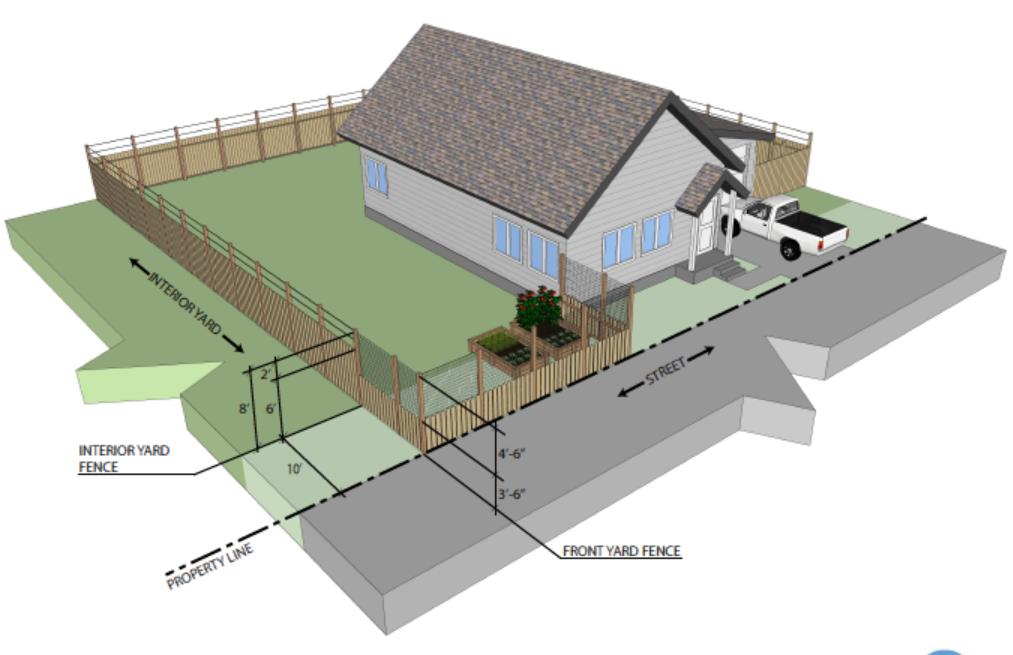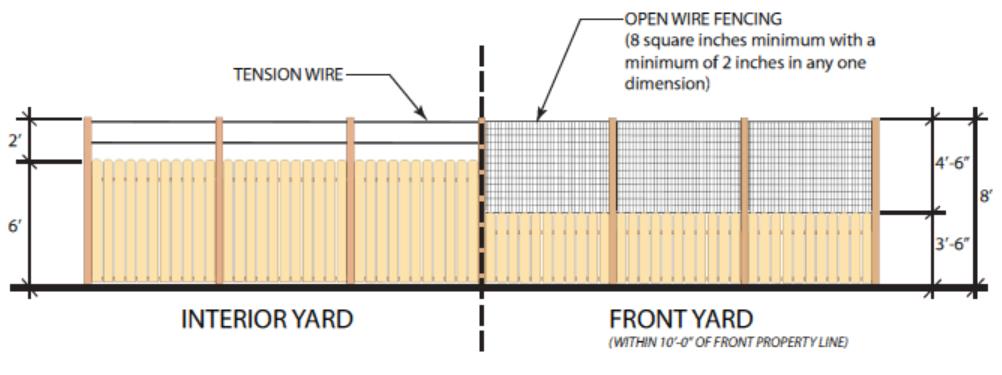Chapter 15.87
Fence Standards
Sections:
15.87.060 Corner or through lot.
15.87.010 Purpose.
The purpose of this chapter is to establish regulations controlling the use of fences, hedges, and walls; whereby the lot owner may have the privilege of privacy and landscape design within his or her own lot with due consideration to the environment of his or her neighbor, the safety of the public, the individual and the general appearance of the community. [Ord. 748, 2015.]
15.87.020 Scope.
This chapter shall apply to all zoning districts. The fence regulations herein shall not apply to any permanent fence erected prior to the effective date of this adoption. [Ord. 748, 2015.]
15.87.030 Definitions.
“Deer fence” means a structure erected to allow light and air for the proper growth of gardens or other plant life with the purpose of keeping animals out of a defined area. The structure may be as high as eight feet and materials may include polypropylene netting, taut wires and woven wire mesh that are adequate at keeping animals such as deer out.
“Fence” means any structure composed of wood, iron, steel, shrubbery, hedges or other material erected in such a manner and position as to enclose or partially enclose all or any part of any premises. Trellises or other structures supporting or for the purpose of supporting vines, flowers and other vegetation when erected in such position as to enclose all or any part of any premises shall be included within the definition of the word “fence.”
“Fence height” is the vertical distance measured from the natural grade to the highest point of the fence including structural supports.
“Measurements” shall mean the required yard setbacks will be measured from the actual property line or closest proximity and not from the paved portion of the right-of-way.
“Property line verification” means the City will use GIS and other means to determine the general location of property lines, plus or minus one or two feet. An official, certified survey document completed by a surveyor licensed in the State of Oregon may be used by an applicant or required in certain situations. All costs for any official survey shall be the sole responsibility of the applicant and/or the property owner.
“Right-of-way” means a City-owned street, alley, easement, or through way, and/or utility owned easements. City-owned rights-of-way vary in width but are always wider than the paved portion that exists within said rights-of-way. Paved portions of rights-of-way are not always centered in any given right-of-way.
“Vision clearance” means the area near intersections of rights-of-way, curb cuts and other roadway entry points where a clear field of vision is necessary for traffic safety. Vision clearance shall be determined by the City Administrator or designee using City standards, State or Federal traffic guidelines. The City Engineer may be used for vision clearance review at the property owner’s and/or applicant’s expense. [Ord. 748, 2015.]
15.87.040 Permitted fences.
Fences shall be permitted in required yards as follows:
A. Fences. Shall be permitted in public facilities and all zoning districts.
1. Front Yards. Fences may be erected in front yards parallel to the building line to a height not exceeding three and one-half feet.
2. Side and Rear Yards. Fences may be erected in side and rear yards as described herein and shall be at least one foot from the property line, unless a certified survey (property line verification) is obtained or existing property pins have been located.
B. Chain Link Fences. Shall be permitted in all zoning districts.
C. Privacy Fences. Shall be permitted in all zoning districts in rear and side yards. Fences shall not exceed six feet in height above the natural grade unless a building permit is obtained.
D. Shrubbery or Hedges. Shall be permitted in public facilities and all zoning districts provided they do not encroach upon the abutting property. Responsible owner shall maintain shrubbery and grass on both sides of the vegetation.
E. Barbed Wire or Stockade Fences. Shall be permitted in the light and heavy industrial zones only in rear and side yards. Said fences may be to a height not exceeding six feet unless a building permit is obtained.
F. Deer Fencing.
1. Deer fencing may be standalone or be attached to a permitted front, side or rear yard fence(s) provided the area is not in excess of the maximum allowable fence heights. Fences shall be designed and constructed to provide a clear view through the fence.
a. Within required front yards, at least 85 percent of the surface shall be unobstructed to both light and air when viewed perpendicular to the place of the fence.
b. Within required side and rear yards at least 80 percent of the surface shall be unobstructed to both light and air when viewed perpendicular to the place of the fence.
2. Deer fencing shall have a minimum height of six and one-half feet and shall not exceed eight feet above grade.
3. Permitted deer fencing materials may include woven wire fencing, field fence, “hog panels,” wire strand or polypropylene mesh net that is open and visible through the material. Within front yards all mesh material shall have a minimum open diameter of one and one-half square inches.
4. Deer fencing shall be supported by structural supports, or tension wires, that run along the top of the fence to prevent sagging.
5. Chain link fences shall not be considered to be deer fences under this section even if they meet the criteria above.


G. General. Any and all fences shall comply with vision clearance distances as described herein. All fences must be constructed of wood, chain link, stone, rock, concrete block, masonry brick, brick, decorative wrought iron, or other material(s) which are similar in durability. Unacceptable fence materials include cast-off, secondhand, and other items not originally intended to be fencing (examples include plywood less than five-eighths-inch thick, low-grade plywood, particle board, paper, visqueen plastic, plastic tarp and similar materials, razor wire and other dangerous materials, sheet metal, roll metal, and corrugated metal).
All applicants shall ensure that they have obtained the proper permission from any abutting utility or franchisee. Fences may not cross any nonexclusive ingress/egress easements. The following utilities or franchises may be contacted regarding easements:
|
• |
Electrical – Pacific Power Company |
|
• |
Natural gas – Northwest Natural Gas |
|
• |
Water, sewer or drainage – City of Brownsville |
|
• |
Telephone – CenturyLink |
No fence shall extend beyond the property line. [Ord. 748, 2015.]
15.87.050 Similar fences.
The City Administrator or designee may permit other fences which are similar in character, design and materials to one or more of the fences permitted by this chapter. [Ord. 748, 2015.]
15.87.060 Corner or through lot.
Where any part of a fence either in a front, rear or side yard abuts a street or other public rights-of-way, fences shall provide adequate vision clearance which may require review from the City Engineer at the owner’s expense. Vision clearance shall be determined by the City Administrator or designee using City standards, State or Federal traffic guidelines. [Ord. 748, 2015.]
15.87.070 Maintenance.
Such permitted fences shall be maintained in good condition and be structurally sound. Fences shall also not be overgrown with vines and weeds. [Ord. 748, 2015.]
15.87.080 Permit.
Any fence which may be permitted shall require the issuance of a permit and approval by the City prior to its erection. Prior to the construction of any fence, an application to construct the fence must be obtained from the City of Brownsville, together with a plot plan showing the location and dimensions of the property to be fenced and the location of the proposed fence, as well as the permit fee as adopted by resolution of Council. [Ord. 748, 2015.]
15.87.090 Inspection.
It shall be the duty of each property owner to determine property lines and to ascertain that the fence thus constructed does not deviate from the plans as approved by the City. The City shall furnish such inspection as is deemed necessary to determine that said fence is constructed in accordance with plans submitted per the permit application. The issuance of any fence permit by the City shall not be construed as to mean the City has determined said fence is not encroaching upon another lot, nor shall it relieve the property owner of the duty imposed herein. [Ord. 748, 2015.]


